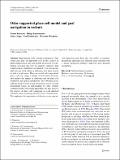Files in this item
Odor supported place cell model and goal navigation in rodents
Item metadata
| dc.contributor.author | Tamosiunaite, Minija | |
| dc.contributor.author | Kulvicius, Tomas | |
| dc.contributor.author | Ainge, James | |
| dc.contributor.author | Dudchenko, Paul | |
| dc.contributor.author | Woergoetter, Florentin | |
| dc.date.accessioned | 2020-12-07T15:24:54Z | |
| dc.date.available | 2020-12-07T15:24:54Z | |
| dc.date.issued | 2008-12 | |
| dc.identifier | 421414 | |
| dc.identifier | bff52fde-f7a7-4dfb-913f-895e17101fee | |
| dc.identifier | 000259438100005 | |
| dc.identifier | 53149108981 | |
| dc.identifier | 77953323850 | |
| dc.identifier.citation | Tamosiunaite , M , Kulvicius , T , Ainge , J , Dudchenko , P & Woergoetter , F 2008 , ' Odor supported place cell model and goal navigation in rodents ' , Journal of Computational Neuroscience , vol. 25 , pp. 481-500 . https://doi.org/10.1007/s10827-008-0090-x | en |
| dc.identifier.issn | 0929-5313 | |
| dc.identifier.other | ORCID: /0000-0002-0007-1533/work/84315524 | |
| dc.identifier.uri | https://hdl.handle.net/10023/21058 | |
| dc.description.abstract | Experiments with rodents demonstrate that visual cues play an important role in the control of hippocampal place cells and spatial navigation. Nevertheless, rats may also rely on auditory, olfactory and somatosensory stimuli for orientation. It is also known that rats can track odors or self-generated scent marks to find a food source. Here we model odor supported place cells by using a simple feed-forward network and analyze the impact of olfactory cues on place cell formation and spatial navigation. The obtained place cells are used to solve a goal navigation task by a novel mechanism based on self-marking by odor patches combined with a Q-learning algorithm. We also analyze the impact of place cell remapping on goal directed behavior when switching between two environments. We emphasize the importance of olfactory cues in place cell formation and show that the utility of environmental and self-generated olfactory cues, together with a mixed navigation strategy, improves goal directed navigation. | |
| dc.format.extent | 20 | |
| dc.format.extent | 1736778 | |
| dc.language.iso | eng | |
| dc.relation.ispartof | Journal of Computational Neuroscience | en |
| dc.subject | Self-marking navigation | en |
| dc.subject | Reinforcement learning | en |
| dc.subject | Q-learning | en |
| dc.subject | Place cell directionality | en |
| dc.subject | Remapping | en |
| dc.subject | BF Psychology | en |
| dc.subject | NDAS | en |
| dc.subject.lcc | BF | en |
| dc.title | Odor supported place cell model and goal navigation in rodents | en |
| dc.type | Journal article | en |
| dc.contributor.institution | University of St Andrews. School of Psychology and Neuroscience | en |
| dc.identifier.doi | 10.1007/s10827-008-0090-x | |
| dc.description.status | Peer reviewed | en |
| dc.identifier.url | https://link.springer.com/article/10.1007/s10827-010-0216-9 | en |
This item appears in the following Collection(s)
Items in the St Andrews Research Repository are protected by copyright, with all rights reserved, unless otherwise indicated.

